Business Law Report: UK Legal System, Business Impact, Disputes
VerifiedAdded on 2021/02/22
|17
|4622
|52
Report
AI Summary
This report provides a comprehensive overview of UK business law, beginning with an introduction to legal systems and legislation impacting businesses, including parliamentary sovereignty, sources of UK law, and the roles of government in law-making and justice. It then delves into the impact of company, employment, and contract law on businesses, providing examples. The report further examines different types of business organizations, with an emphasis on limited companies, including funding and management aspects. It also explores dispute resolution methods with case studies, providing a clear understanding of the legal framework and its practical applications. The report covers statutory and common law, and also includes the relevant case studies to help students gain a better understanding of the topics.
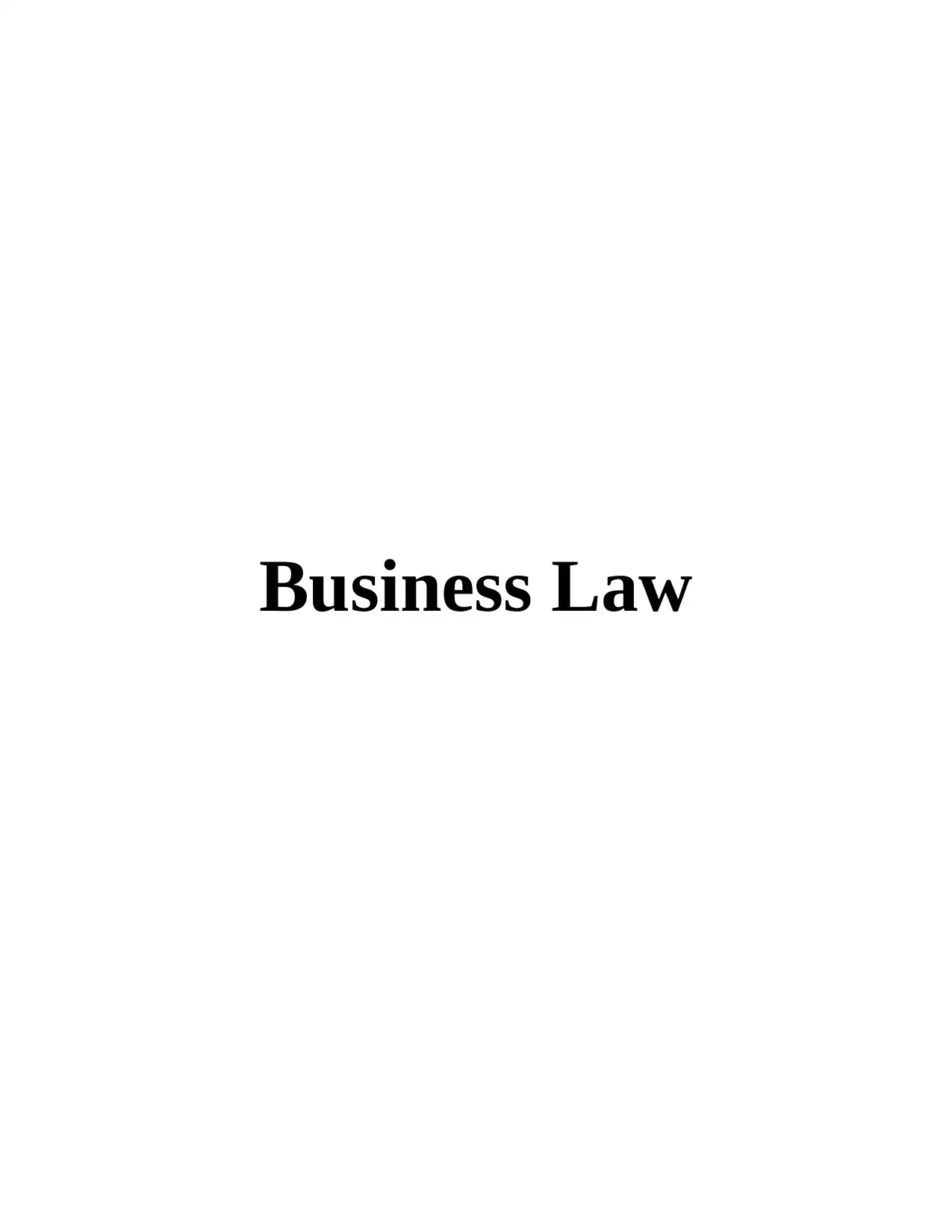
Business Law
Paraphrase This Document
Need a fresh take? Get an instant paraphrase of this document with our AI Paraphraser
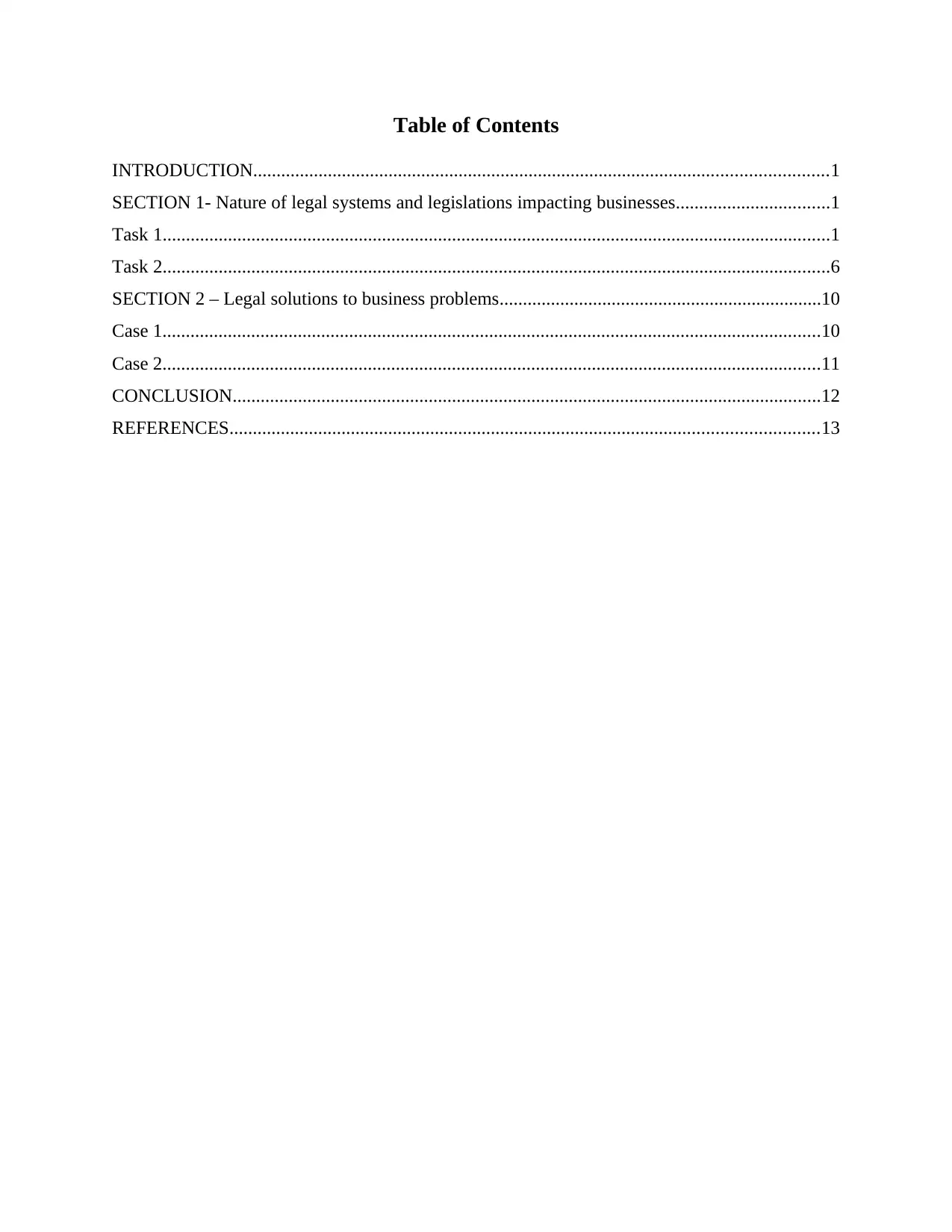
Table of Contents
INTRODUCTION...........................................................................................................................1
SECTION 1- Nature of legal systems and legislations impacting businesses.................................1
Task 1...............................................................................................................................................1
Task 2...............................................................................................................................................6
SECTION 2 – Legal solutions to business problems.....................................................................10
Case 1.............................................................................................................................................10
Case 2.............................................................................................................................................11
CONCLUSION..............................................................................................................................12
REFERENCES..............................................................................................................................13
INTRODUCTION...........................................................................................................................1
SECTION 1- Nature of legal systems and legislations impacting businesses.................................1
Task 1...............................................................................................................................................1
Task 2...............................................................................................................................................6
SECTION 2 – Legal solutions to business problems.....................................................................10
Case 1.............................................................................................................................................10
Case 2.............................................................................................................................................11
CONCLUSION..............................................................................................................................12
REFERENCES..............................................................................................................................13

⊘ This is a preview!⊘
Do you want full access?
Subscribe today to unlock all pages.

Trusted by 1+ million students worldwide
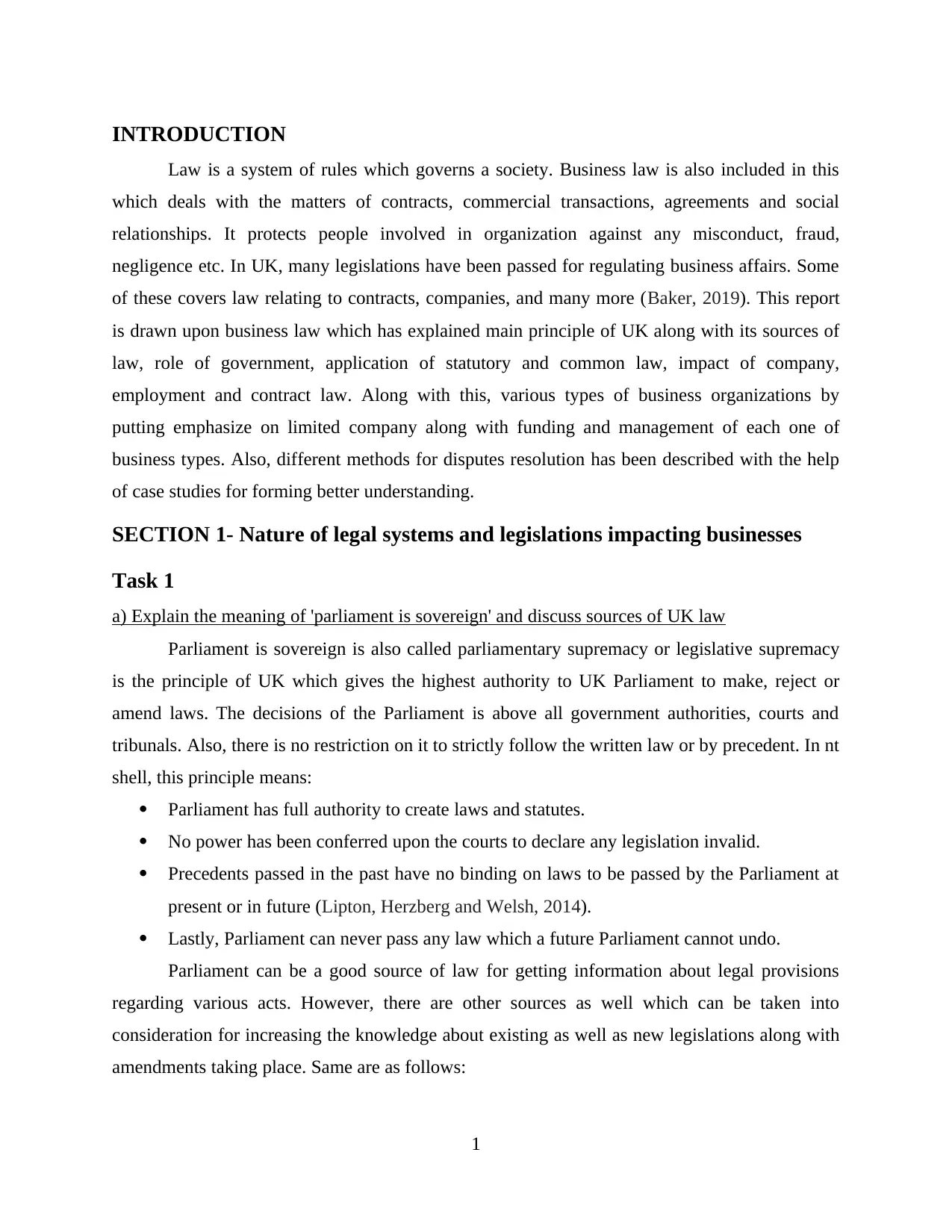
INTRODUCTION
Law is a system of rules which governs a society. Business law is also included in this
which deals with the matters of contracts, commercial transactions, agreements and social
relationships. It protects people involved in organization against any misconduct, fraud,
negligence etc. In UK, many legislations have been passed for regulating business affairs. Some
of these covers law relating to contracts, companies, and many more (Baker, 2019). This report
is drawn upon business law which has explained main principle of UK along with its sources of
law, role of government, application of statutory and common law, impact of company,
employment and contract law. Along with this, various types of business organizations by
putting emphasize on limited company along with funding and management of each one of
business types. Also, different methods for disputes resolution has been described with the help
of case studies for forming better understanding.
SECTION 1- Nature of legal systems and legislations impacting businesses
Task 1
a) Explain the meaning of 'parliament is sovereign' and discuss sources of UK law
Parliament is sovereign is also called parliamentary supremacy or legislative supremacy
is the principle of UK which gives the highest authority to UK Parliament to make, reject or
amend laws. The decisions of the Parliament is above all government authorities, courts and
tribunals. Also, there is no restriction on it to strictly follow the written law or by precedent. In nt
shell, this principle means:
Parliament has full authority to create laws and statutes.
No power has been conferred upon the courts to declare any legislation invalid.
Precedents passed in the past have no binding on laws to be passed by the Parliament at
present or in future (Lipton, Herzberg and Welsh, 2014).
Lastly, Parliament can never pass any law which a future Parliament cannot undo.
Parliament can be a good source of law for getting information about legal provisions
regarding various acts. However, there are other sources as well which can be taken into
consideration for increasing the knowledge about existing as well as new legislations along with
amendments taking place. Same are as follows:
1
Law is a system of rules which governs a society. Business law is also included in this
which deals with the matters of contracts, commercial transactions, agreements and social
relationships. It protects people involved in organization against any misconduct, fraud,
negligence etc. In UK, many legislations have been passed for regulating business affairs. Some
of these covers law relating to contracts, companies, and many more (Baker, 2019). This report
is drawn upon business law which has explained main principle of UK along with its sources of
law, role of government, application of statutory and common law, impact of company,
employment and contract law. Along with this, various types of business organizations by
putting emphasize on limited company along with funding and management of each one of
business types. Also, different methods for disputes resolution has been described with the help
of case studies for forming better understanding.
SECTION 1- Nature of legal systems and legislations impacting businesses
Task 1
a) Explain the meaning of 'parliament is sovereign' and discuss sources of UK law
Parliament is sovereign is also called parliamentary supremacy or legislative supremacy
is the principle of UK which gives the highest authority to UK Parliament to make, reject or
amend laws. The decisions of the Parliament is above all government authorities, courts and
tribunals. Also, there is no restriction on it to strictly follow the written law or by precedent. In nt
shell, this principle means:
Parliament has full authority to create laws and statutes.
No power has been conferred upon the courts to declare any legislation invalid.
Precedents passed in the past have no binding on laws to be passed by the Parliament at
present or in future (Lipton, Herzberg and Welsh, 2014).
Lastly, Parliament can never pass any law which a future Parliament cannot undo.
Parliament can be a good source of law for getting information about legal provisions
regarding various acts. However, there are other sources as well which can be taken into
consideration for increasing the knowledge about existing as well as new legislations along with
amendments taking place. Same are as follows:
1
Paraphrase This Document
Need a fresh take? Get an instant paraphrase of this document with our AI Paraphraser
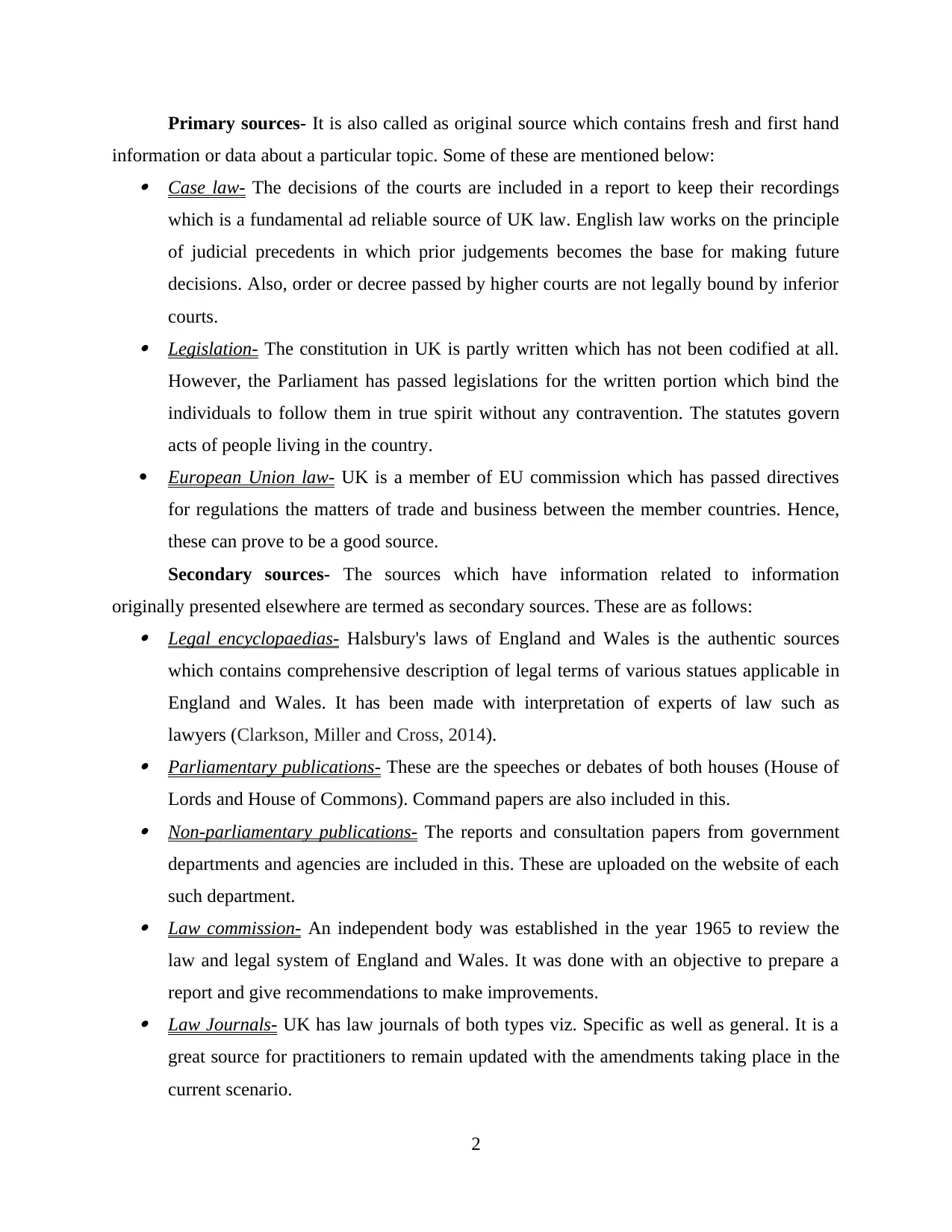
Primary sources- It is also called as original source which contains fresh and first hand
information or data about a particular topic. Some of these are mentioned below: Case law- The decisions of the courts are included in a report to keep their recordings
which is a fundamental ad reliable source of UK law. English law works on the principle
of judicial precedents in which prior judgements becomes the base for making future
decisions. Also, order or decree passed by higher courts are not legally bound by inferior
courts. Legislation- The constitution in UK is partly written which has not been codified at all.
However, the Parliament has passed legislations for the written portion which bind the
individuals to follow them in true spirit without any contravention. The statutes govern
acts of people living in the country.
European Union law- UK is a member of EU commission which has passed directives
for regulations the matters of trade and business between the member countries. Hence,
these can prove to be a good source.
Secondary sources- The sources which have information related to information
originally presented elsewhere are termed as secondary sources. These are as follows: Legal encyclopaedias- Halsbury's laws of England and Wales is the authentic sources
which contains comprehensive description of legal terms of various statues applicable in
England and Wales. It has been made with interpretation of experts of law such as
lawyers (Clarkson, Miller and Cross, 2014). Parliamentary publications- These are the speeches or debates of both houses (House of
Lords and House of Commons). Command papers are also included in this. Non-parliamentary publications- The reports and consultation papers from government
departments and agencies are included in this. These are uploaded on the website of each
such department. Law commission- An independent body was established in the year 1965 to review the
law and legal system of England and Wales. It was done with an objective to prepare a
report and give recommendations to make improvements. Law Journals- UK has law journals of both types viz. Specific as well as general. It is a
great source for practitioners to remain updated with the amendments taking place in the
current scenario.
2
information or data about a particular topic. Some of these are mentioned below: Case law- The decisions of the courts are included in a report to keep their recordings
which is a fundamental ad reliable source of UK law. English law works on the principle
of judicial precedents in which prior judgements becomes the base for making future
decisions. Also, order or decree passed by higher courts are not legally bound by inferior
courts. Legislation- The constitution in UK is partly written which has not been codified at all.
However, the Parliament has passed legislations for the written portion which bind the
individuals to follow them in true spirit without any contravention. The statutes govern
acts of people living in the country.
European Union law- UK is a member of EU commission which has passed directives
for regulations the matters of trade and business between the member countries. Hence,
these can prove to be a good source.
Secondary sources- The sources which have information related to information
originally presented elsewhere are termed as secondary sources. These are as follows: Legal encyclopaedias- Halsbury's laws of England and Wales is the authentic sources
which contains comprehensive description of legal terms of various statues applicable in
England and Wales. It has been made with interpretation of experts of law such as
lawyers (Clarkson, Miller and Cross, 2014). Parliamentary publications- These are the speeches or debates of both houses (House of
Lords and House of Commons). Command papers are also included in this. Non-parliamentary publications- The reports and consultation papers from government
departments and agencies are included in this. These are uploaded on the website of each
such department. Law commission- An independent body was established in the year 1965 to review the
law and legal system of England and Wales. It was done with an objective to prepare a
report and give recommendations to make improvements. Law Journals- UK has law journals of both types viz. Specific as well as general. It is a
great source for practitioners to remain updated with the amendments taking place in the
current scenario.
2
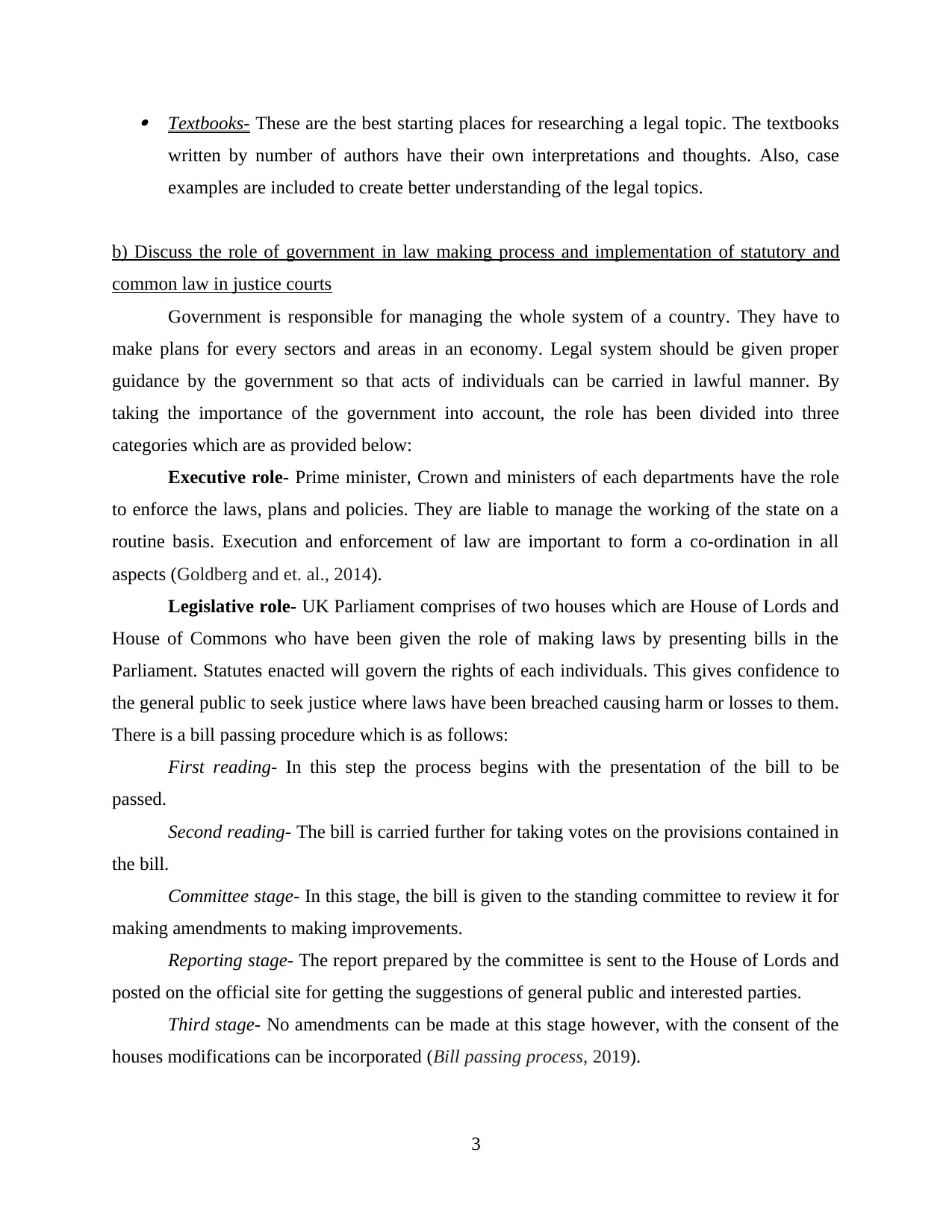
Textbooks- These are the best starting places for researching a legal topic. The textbooks
written by number of authors have their own interpretations and thoughts. Also, case
examples are included to create better understanding of the legal topics.
b) Discuss the role of government in law making process and implementation of statutory and
common law in justice courts
Government is responsible for managing the whole system of a country. They have to
make plans for every sectors and areas in an economy. Legal system should be given proper
guidance by the government so that acts of individuals can be carried in lawful manner. By
taking the importance of the government into account, the role has been divided into three
categories which are as provided below:
Executive role- Prime minister, Crown and ministers of each departments have the role
to enforce the laws, plans and policies. They are liable to manage the working of the state on a
routine basis. Execution and enforcement of law are important to form a co-ordination in all
aspects (Goldberg and et. al., 2014).
Legislative role- UK Parliament comprises of two houses which are House of Lords and
House of Commons who have been given the role of making laws by presenting bills in the
Parliament. Statutes enacted will govern the rights of each individuals. This gives confidence to
the general public to seek justice where laws have been breached causing harm or losses to them.
There is a bill passing procedure which is as follows:
First reading- In this step the process begins with the presentation of the bill to be
passed.
Second reading- The bill is carried further for taking votes on the provisions contained in
the bill.
Committee stage- In this stage, the bill is given to the standing committee to review it for
making amendments to making improvements.
Reporting stage- The report prepared by the committee is sent to the House of Lords and
posted on the official site for getting the suggestions of general public and interested parties.
Third stage- No amendments can be made at this stage however, with the consent of the
houses modifications can be incorporated (Bill passing process, 2019).
3
written by number of authors have their own interpretations and thoughts. Also, case
examples are included to create better understanding of the legal topics.
b) Discuss the role of government in law making process and implementation of statutory and
common law in justice courts
Government is responsible for managing the whole system of a country. They have to
make plans for every sectors and areas in an economy. Legal system should be given proper
guidance by the government so that acts of individuals can be carried in lawful manner. By
taking the importance of the government into account, the role has been divided into three
categories which are as provided below:
Executive role- Prime minister, Crown and ministers of each departments have the role
to enforce the laws, plans and policies. They are liable to manage the working of the state on a
routine basis. Execution and enforcement of law are important to form a co-ordination in all
aspects (Goldberg and et. al., 2014).
Legislative role- UK Parliament comprises of two houses which are House of Lords and
House of Commons who have been given the role of making laws by presenting bills in the
Parliament. Statutes enacted will govern the rights of each individuals. This gives confidence to
the general public to seek justice where laws have been breached causing harm or losses to them.
There is a bill passing procedure which is as follows:
First reading- In this step the process begins with the presentation of the bill to be
passed.
Second reading- The bill is carried further for taking votes on the provisions contained in
the bill.
Committee stage- In this stage, the bill is given to the standing committee to review it for
making amendments to making improvements.
Reporting stage- The report prepared by the committee is sent to the House of Lords and
posted on the official site for getting the suggestions of general public and interested parties.
Third stage- No amendments can be made at this stage however, with the consent of the
houses modifications can be incorporated (Bill passing process, 2019).
3
⊘ This is a preview!⊘
Do you want full access?
Subscribe today to unlock all pages.

Trusted by 1+ million students worldwide
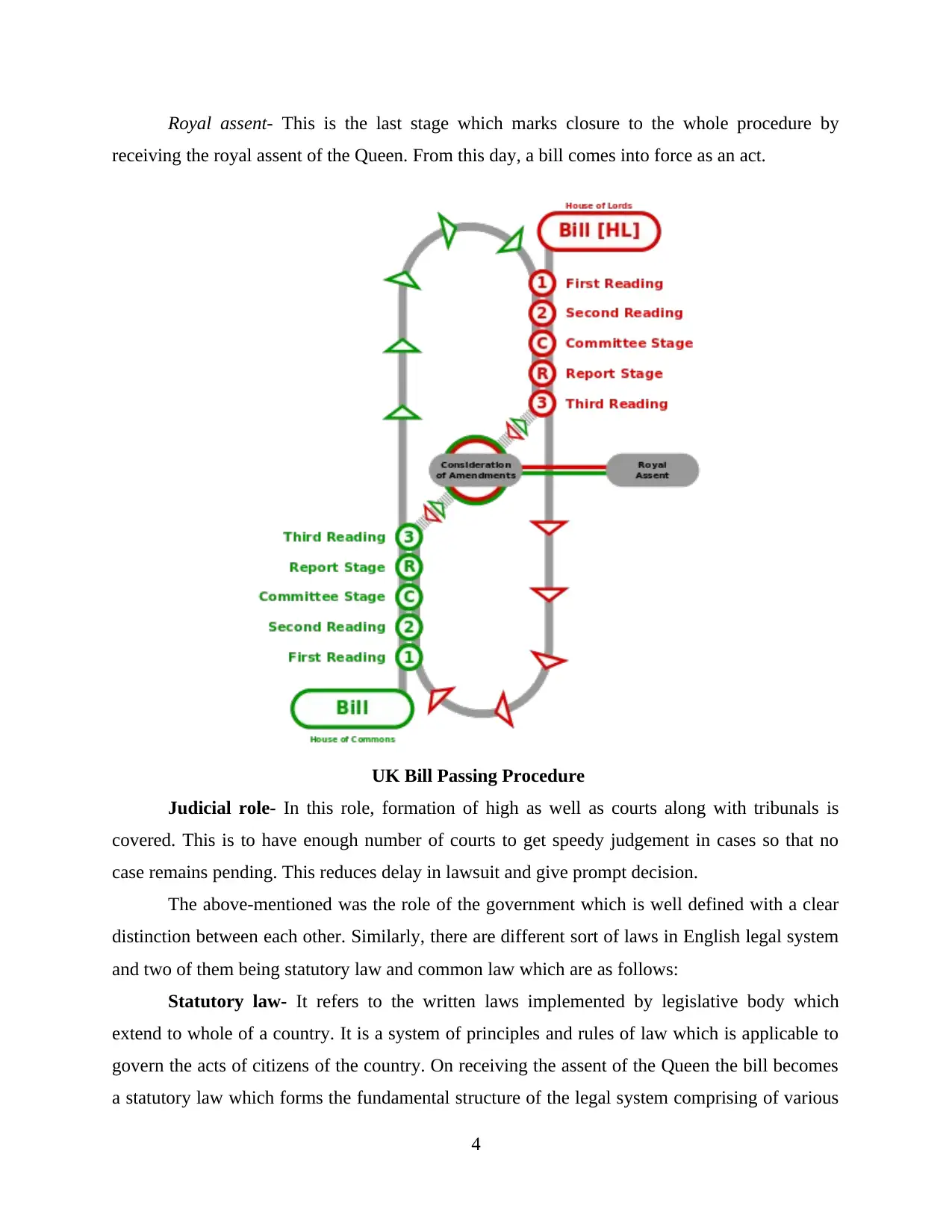
Royal assent- This is the last stage which marks closure to the whole procedure by
receiving the royal assent of the Queen. From this day, a bill comes into force as an act.
UK Bill Passing Procedure
Judicial role- In this role, formation of high as well as courts along with tribunals is
covered. This is to have enough number of courts to get speedy judgement in cases so that no
case remains pending. This reduces delay in lawsuit and give prompt decision.
The above-mentioned was the role of the government which is well defined with a clear
distinction between each other. Similarly, there are different sort of laws in English legal system
and two of them being statutory law and common law which are as follows:
Statutory law- It refers to the written laws implemented by legislative body which
extend to whole of a country. It is a system of principles and rules of law which is applicable to
govern the acts of citizens of the country. On receiving the assent of the Queen the bill becomes
a statutory law which forms the fundamental structure of the legal system comprising of various
4
receiving the royal assent of the Queen. From this day, a bill comes into force as an act.
UK Bill Passing Procedure
Judicial role- In this role, formation of high as well as courts along with tribunals is
covered. This is to have enough number of courts to get speedy judgement in cases so that no
case remains pending. This reduces delay in lawsuit and give prompt decision.
The above-mentioned was the role of the government which is well defined with a clear
distinction between each other. Similarly, there are different sort of laws in English legal system
and two of them being statutory law and common law which are as follows:
Statutory law- It refers to the written laws implemented by legislative body which
extend to whole of a country. It is a system of principles and rules of law which is applicable to
govern the acts of citizens of the country. On receiving the assent of the Queen the bill becomes
a statutory law which forms the fundamental structure of the legal system comprising of various
4
Paraphrase This Document
Need a fresh take? Get an instant paraphrase of this document with our AI Paraphraser
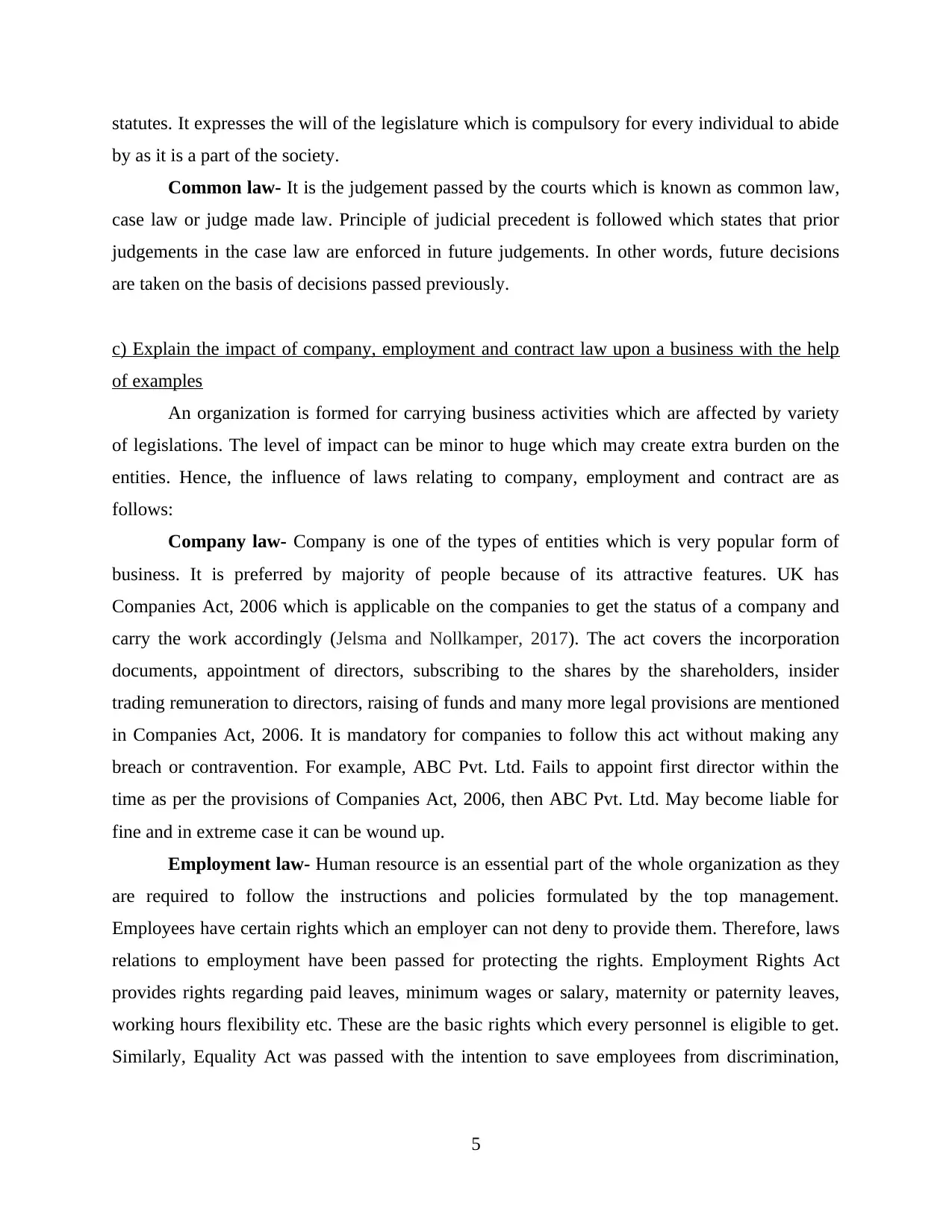
statutes. It expresses the will of the legislature which is compulsory for every individual to abide
by as it is a part of the society.
Common law- It is the judgement passed by the courts which is known as common law,
case law or judge made law. Principle of judicial precedent is followed which states that prior
judgements in the case law are enforced in future judgements. In other words, future decisions
are taken on the basis of decisions passed previously.
c) Explain the impact of company, employment and contract law upon a business with the help
of examples
An organization is formed for carrying business activities which are affected by variety
of legislations. The level of impact can be minor to huge which may create extra burden on the
entities. Hence, the influence of laws relating to company, employment and contract are as
follows:
Company law- Company is one of the types of entities which is very popular form of
business. It is preferred by majority of people because of its attractive features. UK has
Companies Act, 2006 which is applicable on the companies to get the status of a company and
carry the work accordingly (Jelsma and Nollkamper, 2017). The act covers the incorporation
documents, appointment of directors, subscribing to the shares by the shareholders, insider
trading remuneration to directors, raising of funds and many more legal provisions are mentioned
in Companies Act, 2006. It is mandatory for companies to follow this act without making any
breach or contravention. For example, ABC Pvt. Ltd. Fails to appoint first director within the
time as per the provisions of Companies Act, 2006, then ABC Pvt. Ltd. May become liable for
fine and in extreme case it can be wound up.
Employment law- Human resource is an essential part of the whole organization as they
are required to follow the instructions and policies formulated by the top management.
Employees have certain rights which an employer can not deny to provide them. Therefore, laws
relations to employment have been passed for protecting the rights. Employment Rights Act
provides rights regarding paid leaves, minimum wages or salary, maternity or paternity leaves,
working hours flexibility etc. These are the basic rights which every personnel is eligible to get.
Similarly, Equality Act was passed with the intention to save employees from discrimination,
5
by as it is a part of the society.
Common law- It is the judgement passed by the courts which is known as common law,
case law or judge made law. Principle of judicial precedent is followed which states that prior
judgements in the case law are enforced in future judgements. In other words, future decisions
are taken on the basis of decisions passed previously.
c) Explain the impact of company, employment and contract law upon a business with the help
of examples
An organization is formed for carrying business activities which are affected by variety
of legislations. The level of impact can be minor to huge which may create extra burden on the
entities. Hence, the influence of laws relating to company, employment and contract are as
follows:
Company law- Company is one of the types of entities which is very popular form of
business. It is preferred by majority of people because of its attractive features. UK has
Companies Act, 2006 which is applicable on the companies to get the status of a company and
carry the work accordingly (Jelsma and Nollkamper, 2017). The act covers the incorporation
documents, appointment of directors, subscribing to the shares by the shareholders, insider
trading remuneration to directors, raising of funds and many more legal provisions are mentioned
in Companies Act, 2006. It is mandatory for companies to follow this act without making any
breach or contravention. For example, ABC Pvt. Ltd. Fails to appoint first director within the
time as per the provisions of Companies Act, 2006, then ABC Pvt. Ltd. May become liable for
fine and in extreme case it can be wound up.
Employment law- Human resource is an essential part of the whole organization as they
are required to follow the instructions and policies formulated by the top management.
Employees have certain rights which an employer can not deny to provide them. Therefore, laws
relations to employment have been passed for protecting the rights. Employment Rights Act
provides rights regarding paid leaves, minimum wages or salary, maternity or paternity leaves,
working hours flexibility etc. These are the basic rights which every personnel is eligible to get.
Similarly, Equality Act was passed with the intention to save employees from discrimination,
5
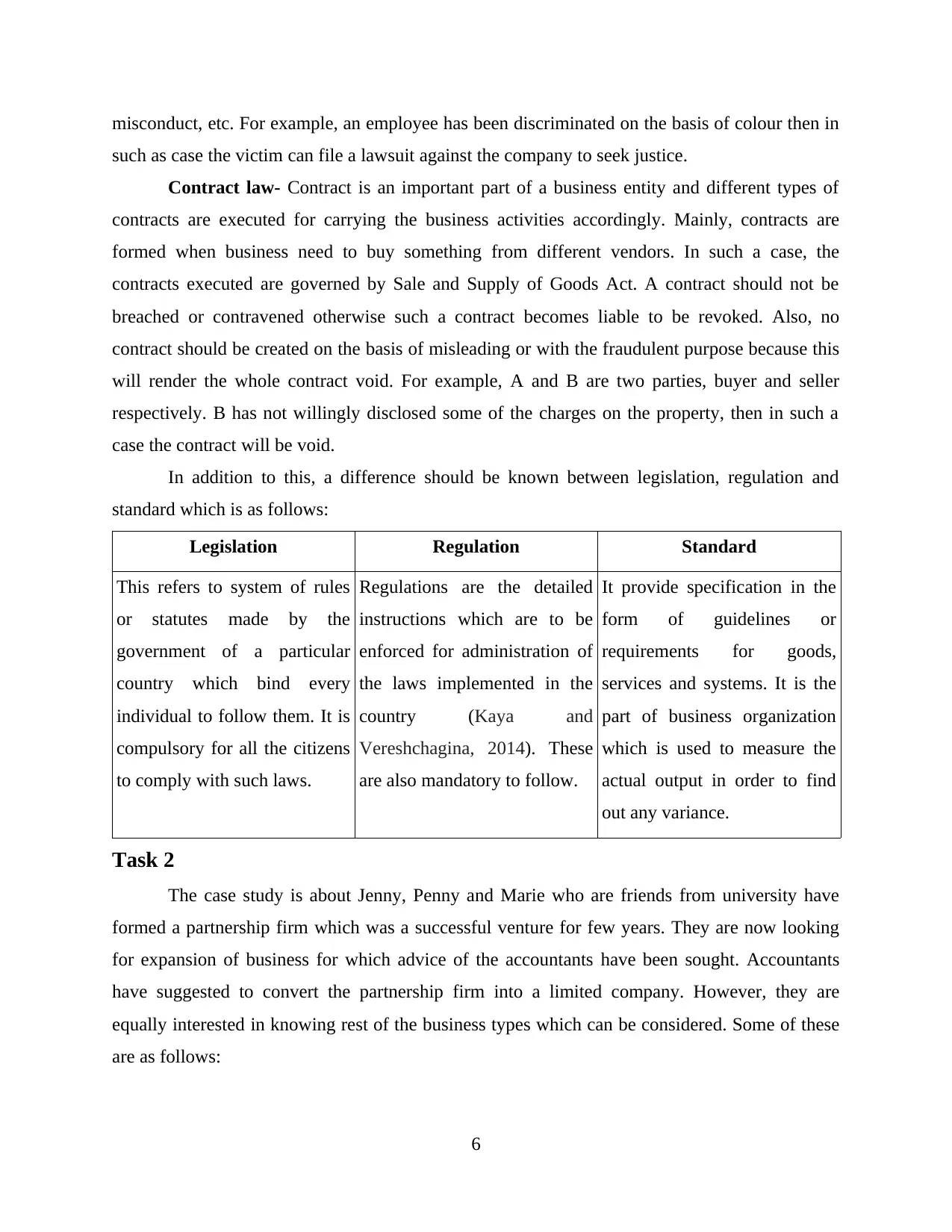
misconduct, etc. For example, an employee has been discriminated on the basis of colour then in
such as case the victim can file a lawsuit against the company to seek justice.
Contract law- Contract is an important part of a business entity and different types of
contracts are executed for carrying the business activities accordingly. Mainly, contracts are
formed when business need to buy something from different vendors. In such a case, the
contracts executed are governed by Sale and Supply of Goods Act. A contract should not be
breached or contravened otherwise such a contract becomes liable to be revoked. Also, no
contract should be created on the basis of misleading or with the fraudulent purpose because this
will render the whole contract void. For example, A and B are two parties, buyer and seller
respectively. B has not willingly disclosed some of the charges on the property, then in such a
case the contract will be void.
In addition to this, a difference should be known between legislation, regulation and
standard which is as follows:
Legislation Regulation Standard
This refers to system of rules
or statutes made by the
government of a particular
country which bind every
individual to follow them. It is
compulsory for all the citizens
to comply with such laws.
Regulations are the detailed
instructions which are to be
enforced for administration of
the laws implemented in the
country (Kaya and
Vereshchagina, 2014). These
are also mandatory to follow.
It provide specification in the
form of guidelines or
requirements for goods,
services and systems. It is the
part of business organization
which is used to measure the
actual output in order to find
out any variance.
Task 2
The case study is about Jenny, Penny and Marie who are friends from university have
formed a partnership firm which was a successful venture for few years. They are now looking
for expansion of business for which advice of the accountants have been sought. Accountants
have suggested to convert the partnership firm into a limited company. However, they are
equally interested in knowing rest of the business types which can be considered. Some of these
are as follows:
6
such as case the victim can file a lawsuit against the company to seek justice.
Contract law- Contract is an important part of a business entity and different types of
contracts are executed for carrying the business activities accordingly. Mainly, contracts are
formed when business need to buy something from different vendors. In such a case, the
contracts executed are governed by Sale and Supply of Goods Act. A contract should not be
breached or contravened otherwise such a contract becomes liable to be revoked. Also, no
contract should be created on the basis of misleading or with the fraudulent purpose because this
will render the whole contract void. For example, A and B are two parties, buyer and seller
respectively. B has not willingly disclosed some of the charges on the property, then in such a
case the contract will be void.
In addition to this, a difference should be known between legislation, regulation and
standard which is as follows:
Legislation Regulation Standard
This refers to system of rules
or statutes made by the
government of a particular
country which bind every
individual to follow them. It is
compulsory for all the citizens
to comply with such laws.
Regulations are the detailed
instructions which are to be
enforced for administration of
the laws implemented in the
country (Kaya and
Vereshchagina, 2014). These
are also mandatory to follow.
It provide specification in the
form of guidelines or
requirements for goods,
services and systems. It is the
part of business organization
which is used to measure the
actual output in order to find
out any variance.
Task 2
The case study is about Jenny, Penny and Marie who are friends from university have
formed a partnership firm which was a successful venture for few years. They are now looking
for expansion of business for which advice of the accountants have been sought. Accountants
have suggested to convert the partnership firm into a limited company. However, they are
equally interested in knowing rest of the business types which can be considered. Some of these
are as follows:
6
⊘ This is a preview!⊘
Do you want full access?
Subscribe today to unlock all pages.

Trusted by 1+ million students worldwide
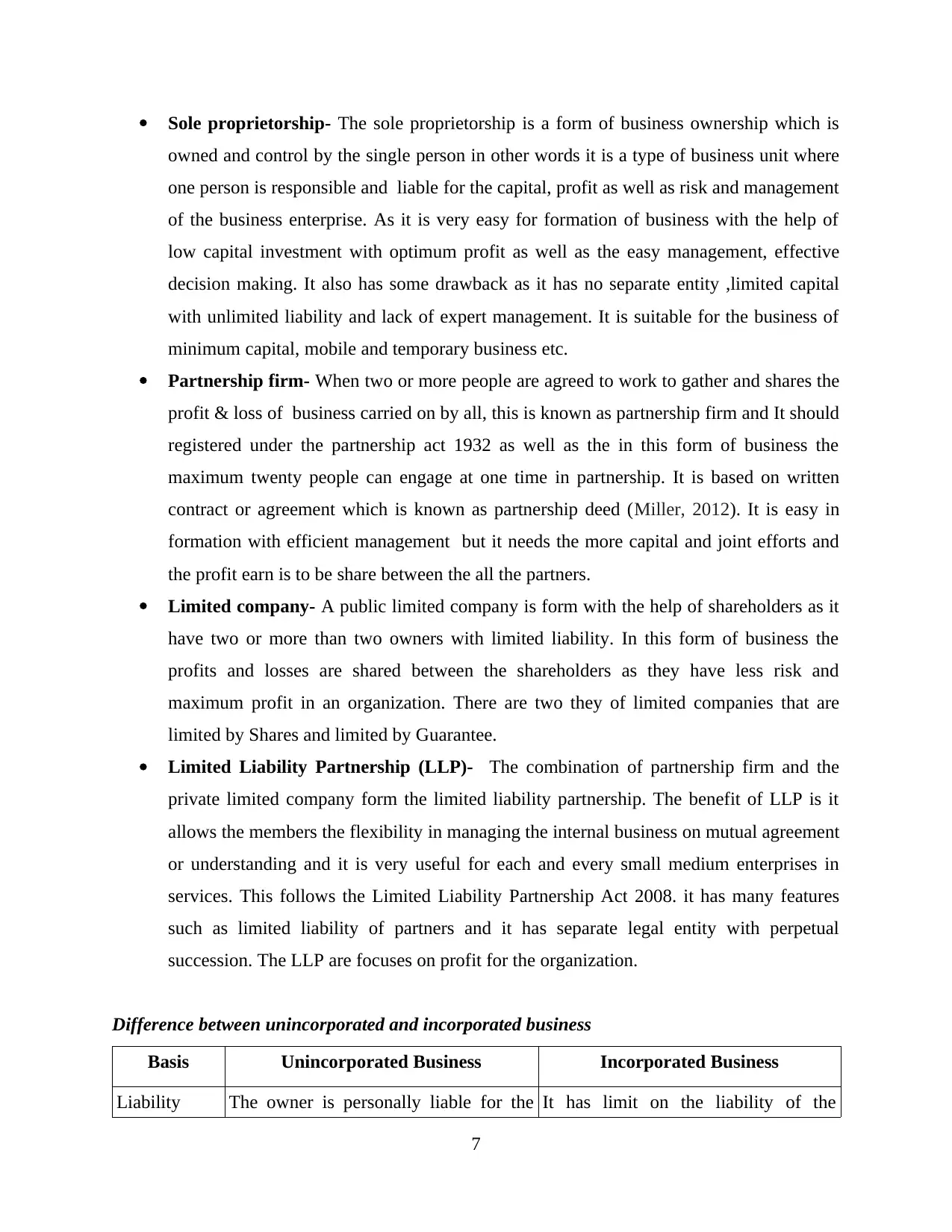
Sole proprietorship- The sole proprietorship is a form of business ownership which is
owned and control by the single person in other words it is a type of business unit where
one person is responsible and liable for the capital, profit as well as risk and management
of the business enterprise. As it is very easy for formation of business with the help of
low capital investment with optimum profit as well as the easy management, effective
decision making. It also has some drawback as it has no separate entity ,limited capital
with unlimited liability and lack of expert management. It is suitable for the business of
minimum capital, mobile and temporary business etc.
Partnership firm- When two or more people are agreed to work to gather and shares the
profit & loss of business carried on by all, this is known as partnership firm and It should
registered under the partnership act 1932 as well as the in this form of business the
maximum twenty people can engage at one time in partnership. It is based on written
contract or agreement which is known as partnership deed (Miller, 2012). It is easy in
formation with efficient management but it needs the more capital and joint efforts and
the profit earn is to be share between the all the partners.
Limited company- A public limited company is form with the help of shareholders as it
have two or more than two owners with limited liability. In this form of business the
profits and losses are shared between the shareholders as they have less risk and
maximum profit in an organization. There are two they of limited companies that are
limited by Shares and limited by Guarantee.
Limited Liability Partnership (LLP)- The combination of partnership firm and the
private limited company form the limited liability partnership. The benefit of LLP is it
allows the members the flexibility in managing the internal business on mutual agreement
or understanding and it is very useful for each and every small medium enterprises in
services. This follows the Limited Liability Partnership Act 2008. it has many features
such as limited liability of partners and it has separate legal entity with perpetual
succession. The LLP are focuses on profit for the organization.
Difference between unincorporated and incorporated business
Basis Unincorporated Business Incorporated Business
Liability The owner is personally liable for the It has limit on the liability of the
7
owned and control by the single person in other words it is a type of business unit where
one person is responsible and liable for the capital, profit as well as risk and management
of the business enterprise. As it is very easy for formation of business with the help of
low capital investment with optimum profit as well as the easy management, effective
decision making. It also has some drawback as it has no separate entity ,limited capital
with unlimited liability and lack of expert management. It is suitable for the business of
minimum capital, mobile and temporary business etc.
Partnership firm- When two or more people are agreed to work to gather and shares the
profit & loss of business carried on by all, this is known as partnership firm and It should
registered under the partnership act 1932 as well as the in this form of business the
maximum twenty people can engage at one time in partnership. It is based on written
contract or agreement which is known as partnership deed (Miller, 2012). It is easy in
formation with efficient management but it needs the more capital and joint efforts and
the profit earn is to be share between the all the partners.
Limited company- A public limited company is form with the help of shareholders as it
have two or more than two owners with limited liability. In this form of business the
profits and losses are shared between the shareholders as they have less risk and
maximum profit in an organization. There are two they of limited companies that are
limited by Shares and limited by Guarantee.
Limited Liability Partnership (LLP)- The combination of partnership firm and the
private limited company form the limited liability partnership. The benefit of LLP is it
allows the members the flexibility in managing the internal business on mutual agreement
or understanding and it is very useful for each and every small medium enterprises in
services. This follows the Limited Liability Partnership Act 2008. it has many features
such as limited liability of partners and it has separate legal entity with perpetual
succession. The LLP are focuses on profit for the organization.
Difference between unincorporated and incorporated business
Basis Unincorporated Business Incorporated Business
Liability The owner is personally liable for the It has limit on the liability of the
7
Paraphrase This Document
Need a fresh take? Get an instant paraphrase of this document with our AI Paraphraser
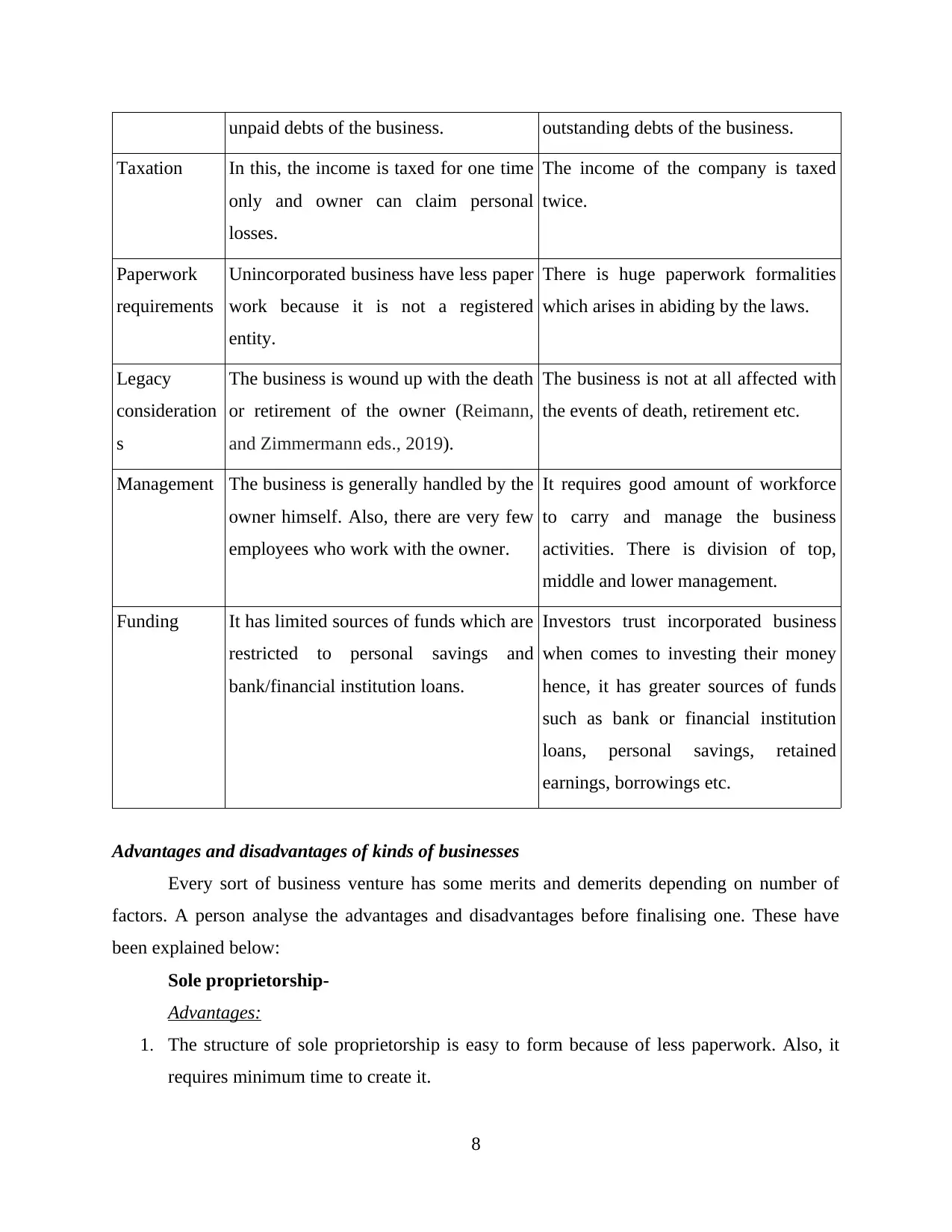
unpaid debts of the business. outstanding debts of the business.
Taxation In this, the income is taxed for one time
only and owner can claim personal
losses.
The income of the company is taxed
twice.
Paperwork
requirements
Unincorporated business have less paper
work because it is not a registered
entity.
There is huge paperwork formalities
which arises in abiding by the laws.
Legacy
consideration
s
The business is wound up with the death
or retirement of the owner (Reimann,
and Zimmermann eds., 2019).
The business is not at all affected with
the events of death, retirement etc.
Management The business is generally handled by the
owner himself. Also, there are very few
employees who work with the owner.
It requires good amount of workforce
to carry and manage the business
activities. There is division of top,
middle and lower management.
Funding It has limited sources of funds which are
restricted to personal savings and
bank/financial institution loans.
Investors trust incorporated business
when comes to investing their money
hence, it has greater sources of funds
such as bank or financial institution
loans, personal savings, retained
earnings, borrowings etc.
Advantages and disadvantages of kinds of businesses
Every sort of business venture has some merits and demerits depending on number of
factors. A person analyse the advantages and disadvantages before finalising one. These have
been explained below:
Sole proprietorship-
Advantages:
1. The structure of sole proprietorship is easy to form because of less paperwork. Also, it
requires minimum time to create it.
8
Taxation In this, the income is taxed for one time
only and owner can claim personal
losses.
The income of the company is taxed
twice.
Paperwork
requirements
Unincorporated business have less paper
work because it is not a registered
entity.
There is huge paperwork formalities
which arises in abiding by the laws.
Legacy
consideration
s
The business is wound up with the death
or retirement of the owner (Reimann,
and Zimmermann eds., 2019).
The business is not at all affected with
the events of death, retirement etc.
Management The business is generally handled by the
owner himself. Also, there are very few
employees who work with the owner.
It requires good amount of workforce
to carry and manage the business
activities. There is division of top,
middle and lower management.
Funding It has limited sources of funds which are
restricted to personal savings and
bank/financial institution loans.
Investors trust incorporated business
when comes to investing their money
hence, it has greater sources of funds
such as bank or financial institution
loans, personal savings, retained
earnings, borrowings etc.
Advantages and disadvantages of kinds of businesses
Every sort of business venture has some merits and demerits depending on number of
factors. A person analyse the advantages and disadvantages before finalising one. These have
been explained below:
Sole proprietorship-
Advantages:
1. The structure of sole proprietorship is easy to form because of less paperwork. Also, it
requires minimum time to create it.
8
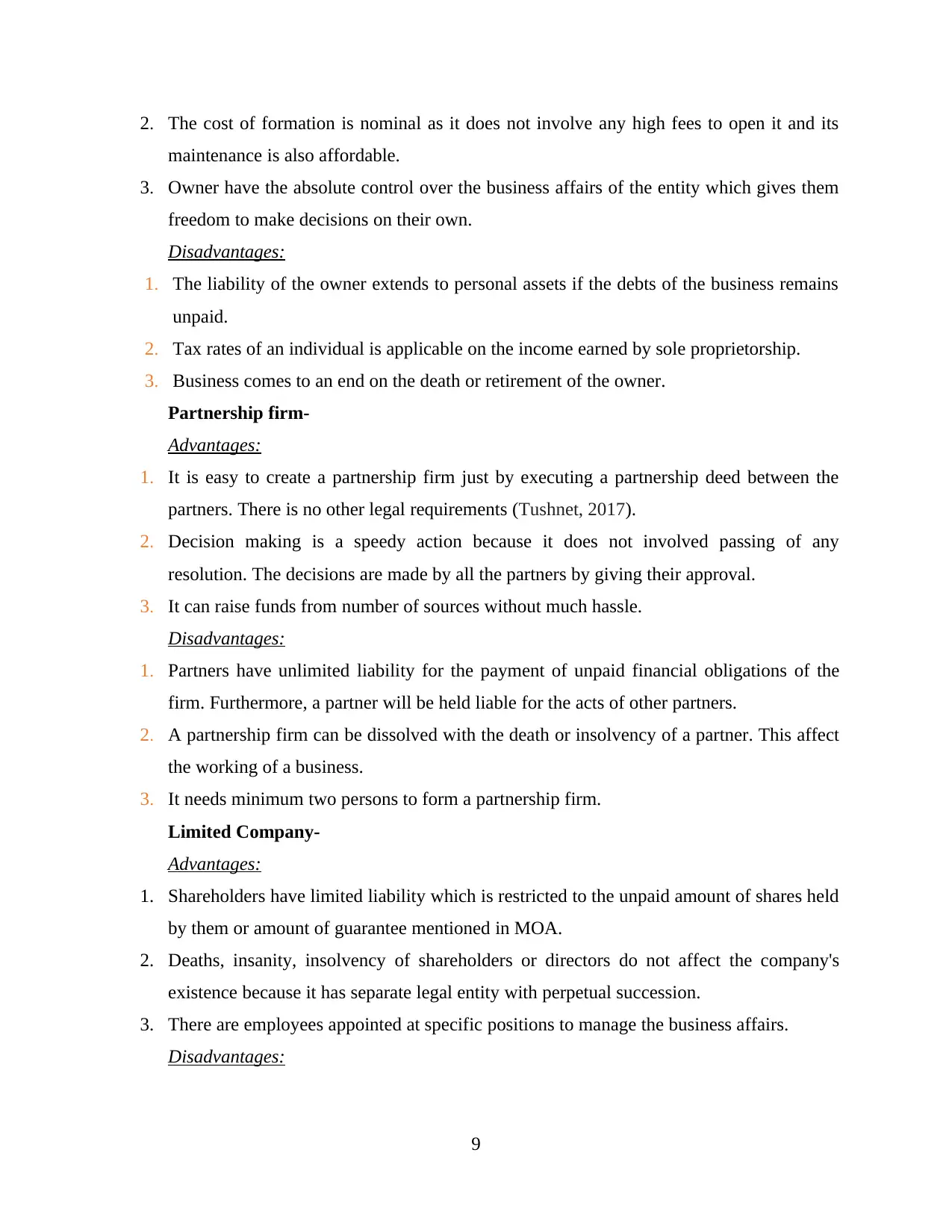
2. The cost of formation is nominal as it does not involve any high fees to open it and its
maintenance is also affordable.
3. Owner have the absolute control over the business affairs of the entity which gives them
freedom to make decisions on their own.
Disadvantages:
1. The liability of the owner extends to personal assets if the debts of the business remains
unpaid.
2. Tax rates of an individual is applicable on the income earned by sole proprietorship.
3. Business comes to an end on the death or retirement of the owner.
Partnership firm-
Advantages:
1. It is easy to create a partnership firm just by executing a partnership deed between the
partners. There is no other legal requirements (Tushnet, 2017).
2. Decision making is a speedy action because it does not involved passing of any
resolution. The decisions are made by all the partners by giving their approval.
3. It can raise funds from number of sources without much hassle.
Disadvantages:
1. Partners have unlimited liability for the payment of unpaid financial obligations of the
firm. Furthermore, a partner will be held liable for the acts of other partners.
2. A partnership firm can be dissolved with the death or insolvency of a partner. This affect
the working of a business.
3. It needs minimum two persons to form a partnership firm.
Limited Company-
Advantages:
1. Shareholders have limited liability which is restricted to the unpaid amount of shares held
by them or amount of guarantee mentioned in MOA.
2. Deaths, insanity, insolvency of shareholders or directors do not affect the company's
existence because it has separate legal entity with perpetual succession.
3. There are employees appointed at specific positions to manage the business affairs.
Disadvantages:
9
maintenance is also affordable.
3. Owner have the absolute control over the business affairs of the entity which gives them
freedom to make decisions on their own.
Disadvantages:
1. The liability of the owner extends to personal assets if the debts of the business remains
unpaid.
2. Tax rates of an individual is applicable on the income earned by sole proprietorship.
3. Business comes to an end on the death or retirement of the owner.
Partnership firm-
Advantages:
1. It is easy to create a partnership firm just by executing a partnership deed between the
partners. There is no other legal requirements (Tushnet, 2017).
2. Decision making is a speedy action because it does not involved passing of any
resolution. The decisions are made by all the partners by giving their approval.
3. It can raise funds from number of sources without much hassle.
Disadvantages:
1. Partners have unlimited liability for the payment of unpaid financial obligations of the
firm. Furthermore, a partner will be held liable for the acts of other partners.
2. A partnership firm can be dissolved with the death or insolvency of a partner. This affect
the working of a business.
3. It needs minimum two persons to form a partnership firm.
Limited Company-
Advantages:
1. Shareholders have limited liability which is restricted to the unpaid amount of shares held
by them or amount of guarantee mentioned in MOA.
2. Deaths, insanity, insolvency of shareholders or directors do not affect the company's
existence because it has separate legal entity with perpetual succession.
3. There are employees appointed at specific positions to manage the business affairs.
Disadvantages:
9
⊘ This is a preview!⊘
Do you want full access?
Subscribe today to unlock all pages.

Trusted by 1+ million students worldwide
1 out of 17
Related Documents
Your All-in-One AI-Powered Toolkit for Academic Success.
+13062052269
info@desklib.com
Available 24*7 on WhatsApp / Email
![[object Object]](/_next/static/media/star-bottom.7253800d.svg)
Unlock your academic potential
Copyright © 2020–2025 A2Z Services. All Rights Reserved. Developed and managed by ZUCOL.




